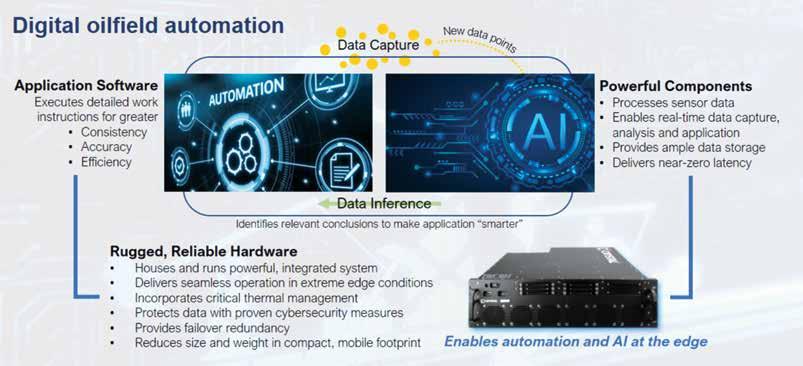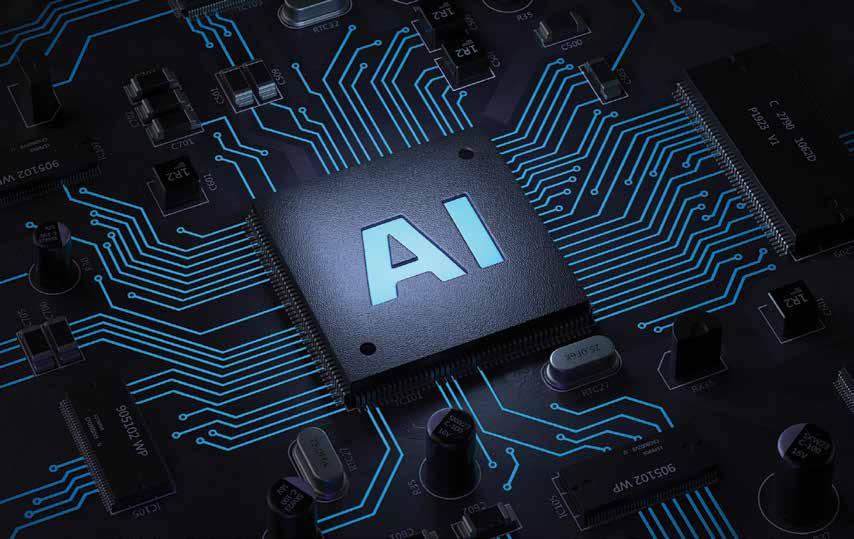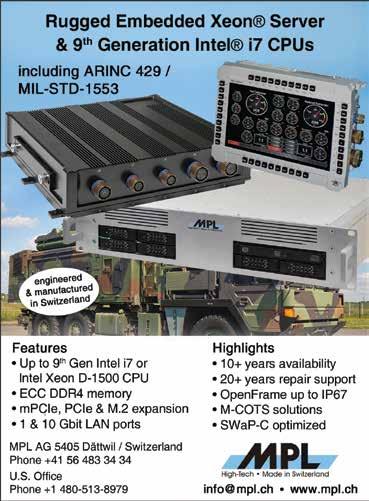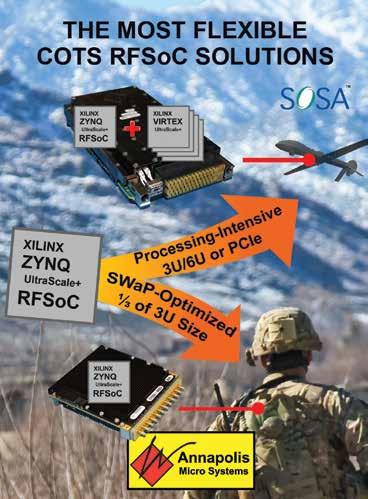
9 minute read
Converging on the Future of Battlefield IT
By Jim Shaw, Executive Vice President of Engineering, Crystal Group
Experimental exercises today are testing out how AI will strengthen tomorrow’s command, control, situational awareness, and more
In commercial work, according to Ryder Systems, heavy trucks experience at least one emergency breakdown annually. The best case is these events’ high mitigation costs, the worst includes serious safety issues. A survey of nine heavy truck fleets, also conducted by Ryder Systems, found typical days out of service (DOS) for a single tractor was 3.19 days per month. This reduction in operating availability is extraordinarily costly.
The 2018 launch of the Department of Defense’s Joint Artificial Intelligence Center (JAIC) wasn’t the earliest step in the military’s pursuit of AI capabilities, but it was one of the first high-profile demonstrations of its serious commitment. What’s followed in the Pentagon’s strides toward advanced battlefield AI—including the 2019 tandem release of a White House American AI Strategy executive order and an official DoD AI Strategy, as well as the 2020 adoption of five DoD Principles for Artificial Intelligence Ethics—have created the foundational doctrine for military-wide accelerated AI development and deployment.
With the necessary E-Ring frameworks, agreements, and parameters in place, the services have kicked off multiple campaigns aimed at harnessing digital transformation in the hunt for AI-powered capabilities that deliver the decisive advantage. The JAIC, as well as older future-focused defense organizations like the Defense Advanced Research Projects Agency, have been at the center of many projects, programs, and campaigns targeting military AI development.
But the rubber hit the road in a big way earlier this year when the Army—joined by elements

of the Air Force and the Marine Corps—kicked off a five-week exercise known as Project Convergence. Held in August and September at Yuma Proving Ground, Arizona, Project Convergence ambitiously tested out multi-platform experiments and demonstrations that pushed the limits of today’s tactical edge multi-domain operations, interoperability, power, speed, network operations, data-sharing, command and control, and more. The exercise leveraged F-35 II Lightning aircraft, long-range precision fires, air, and missile defense systems, sensors spread across the land, air and space, unmanned aircraft, weapons systems including Howitzer artillery, and air and ground assault vehicles.
And the central thread tying it all together in the quest for interoperable, data-driven technological dominance that wins tomorrow’s wars? Artificial intelligence.
“How do you start to combine and connect all these things so they interoperate? It’s bigger than just the signature weapons systems,” Gen. John M. Murray, commander of Army Futures Command, said at a September media briefing. “It’s artificial intelligence. It’s machine learning. It’s the network that will support all that. It’s autonomy, it’s robotics, and it’s the underlying data architectures and how we manage data because when you boil it right down, it all comes down to how you manage that data.”

For the military, “managing data” in tactical scenarios means rapidly collecting, sorting, processing, analyzing, determining actionable relevance, sharing, and using operational information to make split-second decisions in combat. Today’s requirements for linking sensor to shooter in seconds are beyond human capacity—and that’s why the military is turning to battlefield AI as a key solution in troop readiness and lethality.
Technically Speaking: Here’s How We Get There
While Project Convergence was a recent milestone in testing and evaluating AI in a tactical setting, the demand signals behind its fundamental goals—including the cross-service Joint All-Domain Command and Control, or JADC2, for Project Convergence is a pivotal proof of concept—aren’t so new. Manufacturers have been hard at work devising, designing, and manufacturing AI-enabled solutions capable of meeting emerging requirements.
For AI at the tactical edge, those requirements involve more CUDA cores and more small, rugged boxes going into a variety of applications for specific purposes. For example, applications could center on image detection, electronic warfare signatures, or intelligence, surveillance, reconnaissance. At Crystal Group, engineers are currently working to meet the demand for dedicated embedded packages—a departure from
Figure 1: Feature-rich Crystal Group Embedded Computer Systems are powerful, compact, and rugged. Completely and easily configurable, the Embedded product line boasts advanced thermal management and an aluminum chassis and is field-tested to withstand shock and vibration, extended temperature ranges, harsh elements, and harsh environments.


the large, power-consuming devices found in autonomous vehicles. Rather than combining dozens of sensors for situational awareness, it’s a matter of feeding data from one or two sensors into AI engines that are scanning images, looking for changes from frame to frame, and performing edge detection.
The ability to quickly identify a hypersonic missile or a specific type of plume is becoming more promising because devices are becoming more application-specific rather than multipurpose—allowing for a smaller footprint.
The crucial piece is the ability to not just collect edge-sensor data in the field, but also process it, analyze it, help determine actionable intelligence and direct that up the chain of the command—or wherever it needs to go.
“We used ground robots paired with small UAVs to digitally map and transmit that map over the network so that it could be aggregated and then sent across the force,” Brig. Gen. Ross Coffman, director of the Army’s Next-Generation Combat Vehicle Cross-Functional Team, said in a Sept. 23 media roundtable. “We used artificial intelligence to autonomously conduct a ground reconnaissance, employ sensors and then pass that information back. We used artificial intelligence in [air defense artillery] target recognition, and machine learning to train algorithms on various types of enemy forces.”
Coffman added that Projected Convergence was an opportunity to prove the ability to communicate and share data specifically between F-35s and Ospreys to ground forces, passing ground-sensed targets to the aircraft and aircraft-sensed targets to ground operators.
For troops forward-deployed and needing a lot of compute horsepower—for AI, inference engine-type capabilities—exercises like Project Convergence are foundational. Turning tactical-edge data-sorting, reduction, and consolidation from thousands of sensors worldwide into battlefield situational awareness—and doing so in a place that’s definitely not a data center—is a tremendous challenge. Today, warfighters are using a transit case or a mobile truck to receive all that sensor information and create a common operating picture for command and control. But finding a way to do that in a much smaller footprint is clearly where the military is looking to go next.
Informed Operations from the Edge
Edge sensors played an essential role alongside AI in Project Convergence, collecting large amounts of data in many different forms. Take, for example, a camera snapping 240 high-resolution frames per second. Like with drones, that can amount to petabytes of data, but the integration of AI is what separates what’s useful from what’s not.
That’s what’s at the heart of making these sensors AI-capable: to marry quantities of data with an image processor that only sends the important information back to the main compute capacity. It’s not necessary to have massive compute power in, say, an F-35 mission computer, because operators and commanders are only getting data that’s mission-relevant, reducing the computational load. The primary purpose of most edge compute devices is to only send back mission-critical information, which is how the military can get around the pipeline limitations of a disconnected environment.
Project Convergence is, according to the Army, a campaign to demonstrate and begin forging the path toward AI at the tactical edge. Specifically, in a set of demonstrations held Sept. 21 and Sept. 23, participants including much of Army Futures Command—among them, the Army’s AI Task Force and the Future Vertical Lift, Network, Next-Generation Combat Vehicle, and Assured Positioning, Navigation and Timing Cross-Functional Teams— used a two-sensor, two-shooter, two-target format to demonstrate specific threads within an artificial “kill web.”
One of the key AI capabilities used in Project Convergence was FIRES Synchronization to Optimize Responses in Multi-Domain Operations or FIRESTORM. Coffman told reporters that FIRESTORM is a “computer brain that recommends the best shooter, updates the common operating picture with the current enemy situation and friendly situation, [and] admissions the effectors that we want to [use to] eradicate the enemy on the battlefield.”
To train FIRESTORM’s algorithms, the Army reportedly built a database of more than 3.5 million relevant images in varying contexts— and when it comes to training algorithms, the more images, inputs, and repetitions, the more effective the tool.
are effective and secure. It’s also work that requires massive compute power and likely takes place well before deployment, in places like the Pentagon or other headquarters environments where that high-speed computing capacity is available.
Updating the AI model has to be real-time to most competitively keeping pace with operational tempo and emerging threats. Taking the sensor data you’re collecting when you’re seeing that tank or RPG for the first time—that needs to be the first input for your model back at the Pentagon or relevant headquarters to maximize mission effectiveness and security.
Safeguarding the Future of AI-Powered Ops
Emerging technology inherently comes with accompanying emerging vulnerabilities. In this case, one is the danger of failing to keep AI current with the evolving threat landscape.
This truly is a race—the AI threat used against the U.S. is likely going to come from Russia or China. It all comes down to training the model. In the theater troops are using a different kind of an AI engine—an inference engine—that interprets what it sees from the sensor and compares it to the Pentagon’s model algorithm. Tactical AI, and therefore the ability to detect and understand the current tactical situation, is dependent on how good the AI model is. As things change quickly, will the modeling and training of the algorithm keep pace? That’s a key issue when it comes to AI vulnerabilities.
And just as AI is a boon for augmented U.S. military operations, it’s just as much a tool for adversaries with malicious intent. This isn’t a concept that’s lost on the Army. In fact, while Project Convergence was underway in the Arizona desert, the service was also test-driving automated tools for bolstering tactical network resilience and security while also safeguarding AI capabilities.
The 11-week annual Network Modernization Experiment (NetModX) at Joint Base McGuire-Dix-Lakehurst, New Jersey, wrapped in early October after focusing on network resilience, bandwidth, and spectrum. One key goal: employ automation to alleviate manpower shortages, execute cyber defense, and secure deployed AI tools.
“In the battlefield of the future, the expectation is that military networks will operate in a heavily contested environment with enemies attempting to infiltrate and attack friendly networks and systems,” Sanae Benchaaboun, the Army C5ISR Center engineer leading the project at NetModX 20, said ahead of the event. “Human cyber defenders will likely need support to defend the network and intervene where human action may not be possible. At NetModX 20, the Autonomous Cyberteam plans to evaluate three components of the program that use artificial intelligence and machine learning technology to support the human cyber defender in the tactical battlefield.”
Ultimately, Project Convergence—already teeing up for a 2021 iteration—along with NetModX and the many other experiments and exercises underway across the services are defining the future of warfare. That includes offense and defense, networks and weapons systems, ships and ground vehicles and aircraft, and even space and cyberspace. While many questions remain, one aspect is clear: The tactical edge and artificial intelligence will shape the doctrine, training, equipment, and operations to come.




